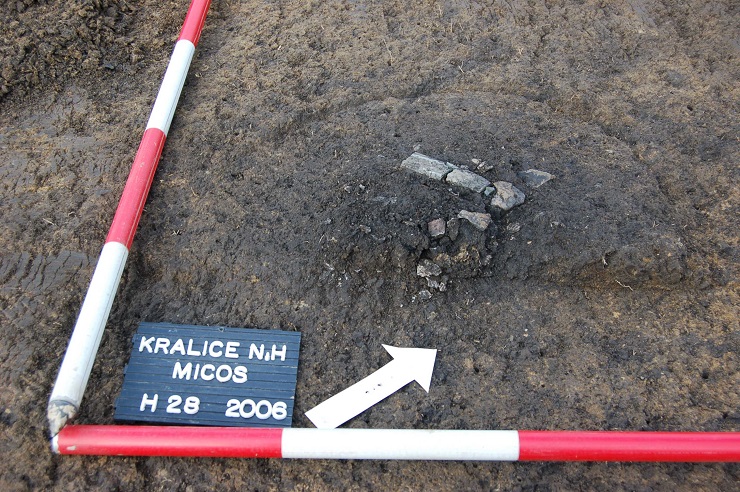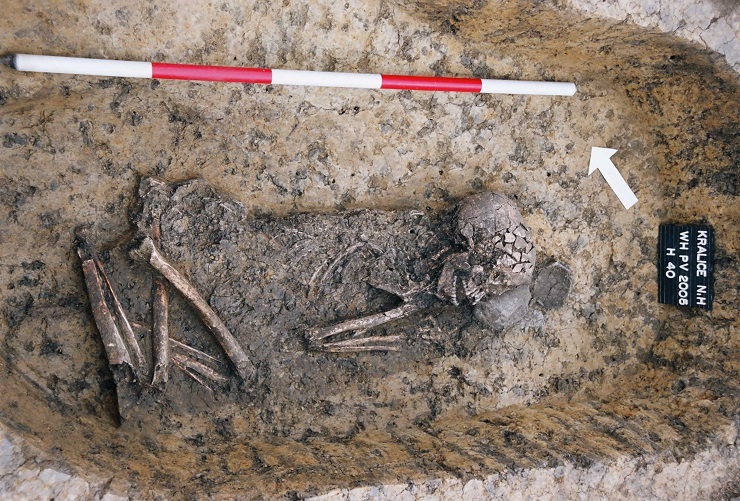|
|
| Skeleton grave (No. 40/05), for a woman aged 25-40 years in Kralice in Haná with the addition of a container that is decorated with an incised linear ornament and a fraction of a grain grinder below her left temple. Photo by Miroslav Šmíd, Institute of Archaeological Heritage Preservation Brno, Prostějov Department. |
The recent discovery of the burial place of the Linear Pottery culture in Kralice in Haná caused a splash in scientific circles. Already the actual discovery of a necropolis dating from this period is significant (in Moravia there are several of them, while in Bohemia they are completely absent), but what is essential is that in addition to the skeletal burials there are mainly burials of cremated remains. The cremation rites, however, do not represent a new phenomenon of the Neolithic era - occasionally they have already appeared during the Palaeolithic and slightly more often during the Mesolithic.
 |
| Cremation grave (No. 28/06) for an adult individual seemed in the field to have a darker spot, together with a few fragments of burnt bones, fragments of ceramic containers and also some parts of the broken cosh. Photo by Miroslav Šmíd, Institute of Archaeological Heritage Preservation Brno, Prostějov Department. |
The burial complex in Kralice is located at the northern edge of the settlement, which has functioned continuously since the early Neolithic period up to the terminal (Šárecký) stage of the Linear Pottery culture. Almost 80 graves were examined there, of which 69 were cremations; the actual necropolis must have had even larger dimensions. In skeletal graves in Kralice appear additions in the form of ceramic containers or coshes. Cremation graves are alike in terms of additions; sometimes they are completely empty. The presence of coshes is usually associated with the male graves, while the pottery is gender neutral. Therefore it does not appear that the society was distinctly stratified. Red pigment was also found in the graves - the reasons for this may be various - from the symbolic level to the beautification of the deceased to some necessary medical practice. The pigment together with the cremation process testifies to abstract thinking and the dualistic concept of body and soul. Fire is usually considered to be both liberating and cathartic, which is probably connected with belief in an afterlife.
Neither a purely material nor any generally applicable spatial pattern of the graves at Neolithic necropolises suggests the existence of any standards or rules in regard to selecting a burial rite. Based on the finding situation at the Kralice site, assumptions concerning the development of a skeletal rite into a cremation within the evolutionary development of the Linear Pottery culture to the Stroked Pottery culture have been challenged.
Want to learn more?
- Farruggia, J.-P. 2002. Une crise majeure de la civilisation du Néolithique Danubien des années 5100 avant notre ére – A major crisis in the Danubian Neolithic at the end of the 6th millennium BC. Archeologické rozhledy 54: 44–98.
- Šmíd, M. 2012. Kostrové a žárové pohřebiště kultury s lineární keramikou v Kralicích na Hané, střední Morava. Pravěk. Supplementum. Brno: Ústav archeologické památkové péče Brno.
- Šmíd, M. 2013. Kralice na Hané. Birituální pohřebiště kultury s lineární keramikou. Archeologické památky střední Moravy. Olomouc: Archeologické centrum Oloumouc.
- Zápotocká, M. 1998. Bestattungsritus des böhmischen Neolithikums (5000–4200 B. C.). Gräber und Gräberfelder der Kultur mit Linear-, Stichband- und Lengyel-Keramik. Praha: Archeologický ústav AV ČR.
 Archeologické 3D virtuální muzeum
Archeologické 3D virtuální muzeum

.png)
